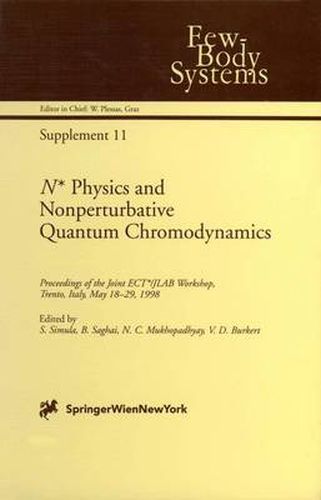Readings Newsletter
Become a Readings Member to make your shopping experience even easier.
Sign in or sign up for free!
You’re not far away from qualifying for FREE standard shipping within Australia
You’ve qualified for FREE standard shipping within Australia
The cart is loading…






This title is printed to order. This book may have been self-published. If so, we cannot guarantee the quality of the content. In the main most books will have gone through the editing process however some may not. We therefore suggest that you be aware of this before ordering this book. If in doubt check either the author or publisher’s details as we are unable to accept any returns unless they are faulty. Please contact us if you have any questions.
The Workshop N* Physics and non-perturbative QeD was held at the Eu ropean Center for Theoretical Studies and Related Areas (ECT*) in Trento, Italy, during May 18-29, 1998. Previous workshops of the series on N* Physics took place at the Florida State University (1994), at CEBAF (1995), at the Institute for Nuclear Theory in Seattle (1996) and at the George Washington University (1997). The Workshop was devoted to a summary of recent experimental and the oretical research on N* phsyics and special emphasis was given to the infor mation that photo-and electro-production of nucleon resonances can provide on the non-perturbative regime of Quantum Chromodynamics. The idea was to stimulate discussions among experimentalists and theoreticians in order to pursue the interpretation of the huge amount of forthcoming data from several laboratories in the world. It was therefore decided to have both experimental and theoretical lectures on the main topics, like ,among the others, single and double pion production, TJ-and K-meson production, the GDH sum rule, the spin of the proton, etc. Thanks to the unusual two-week extension of the Work shop, the allotted time for the lectures was extended up to one hour in order to allow the invited lecturers to give a detailed presentation of their topics. Fi nally, various short contributions were selected to sharpen the discussion about selected items.
$9.00 standard shipping within Australia
FREE standard shipping within Australia for orders over $100.00
Express & International shipping calculated at checkout
This title is printed to order. This book may have been self-published. If so, we cannot guarantee the quality of the content. In the main most books will have gone through the editing process however some may not. We therefore suggest that you be aware of this before ordering this book. If in doubt check either the author or publisher’s details as we are unable to accept any returns unless they are faulty. Please contact us if you have any questions.
The Workshop N* Physics and non-perturbative QeD was held at the Eu ropean Center for Theoretical Studies and Related Areas (ECT*) in Trento, Italy, during May 18-29, 1998. Previous workshops of the series on N* Physics took place at the Florida State University (1994), at CEBAF (1995), at the Institute for Nuclear Theory in Seattle (1996) and at the George Washington University (1997). The Workshop was devoted to a summary of recent experimental and the oretical research on N* phsyics and special emphasis was given to the infor mation that photo-and electro-production of nucleon resonances can provide on the non-perturbative regime of Quantum Chromodynamics. The idea was to stimulate discussions among experimentalists and theoreticians in order to pursue the interpretation of the huge amount of forthcoming data from several laboratories in the world. It was therefore decided to have both experimental and theoretical lectures on the main topics, like ,among the others, single and double pion production, TJ-and K-meson production, the GDH sum rule, the spin of the proton, etc. Thanks to the unusual two-week extension of the Work shop, the allotted time for the lectures was extended up to one hour in order to allow the invited lecturers to give a detailed presentation of their topics. Fi nally, various short contributions were selected to sharpen the discussion about selected items.